Washington is ready to roll out the red carpet for Japanese Prime Minister Fumio Kishida’s official visit starting on April 10. It promises to be a whirlwind of activity. Kishida will participate in a leader’s summit and state dinner, address a joint meeting of Congress (Kishida will be the second Japanese leader ever to do so), and pair his visit with a trilateral summit of Japan, the United States, and the Philippines. These diplomatic engagements’ joint statements will be parsed carefully by watchers of Indo-Pacific affairs to identify new areas of strategic convergence and lines of effort as the hub-and-spoke U.S. alliance system in Asia is increasingly buttressed by groupings of the like-minded.
In no small measure, Japan’s transformation under the late Prime Minister Shinzo Abe into a formidable network power weaving regional economic and security partnerships has significantly assisted the United States’ Indo-Pacific diplomacy. As this more proactive Japan enters its second decade, the question is no longer whether “Japan is back”—Tokyo has already consolidated its position as America’s indispensable ally in Asia. Rather, the issue at hand for President Joe Biden and Kishida is whether they can continue to augment the alliance to meet the challenges of proliferating international conflict, weaponized economic interdependence, and fraught domestic politics.
The Biden-Kishida summit, therefore, provides an opportunity to take stock of three crucial matters: Can Kishida sustain Japan’s proactive leadership? What will the summit deliverables reveal about the alliance’s priorities? And will the heyday of U.S.-Japan cooperation survive a year of elections—at the U.S. federal level and for Japan’s party leadership—that may or may not return Biden and Kishida to office?
Kishida in Washington: More than Abe’s successor
The 2010s were transformative for Japan’s foreign policy. During his tenure as Japan’s longest-serving prime minister, Abe broke the veto power of Japanese agriculture over trade liberalization, paving Japan’s admission to the Trans-Pacific Partnership negotiations. His administration reinterpreted the Japanese Constitution to allow for the right of collective self-defense under certain conditions, which opened new venues for strategic coordination with the United States. Japan’s diplomatic push included a blueprint for regional stability in the Free and Open Indo-Pacific, the revival of the Quad, and proactive engagement with South Asia through infrastructure finance and capacity building in maritime law enforcement. It also saw Japan cultivating security partnerships beyond the United States with nations like Australia and India.
These major accomplishments notwithstanding, the 2020s call for both a second decisive decade in Japan’s foreign policy and renewed efforts at alliance modernization. Quite simply, the challenges are steeper: raging conflicts in Europe and the Middle East; tensions in the Taiwan Strait; an emboldened North Korea using its growing ties to Russia to evade U.N. strictures; the risks of a competitive U.S.-China relationship turning conflictual; and the growing allure of techno-nationalism.
Kishida comes to Washington with a strong record of international leadership. The prime minister took Russia to task for its invasion of Ukraine and committed Japan to much larger defense expenditures. His administration delivered both a new national security strategy identifying China as Japan’s largest security challenge, and a first-of-its-kind Economic Security Promotion Act. Additionally, this time the economy provides tailwinds for Kishida’s trip. With the largest wage hikes in three decades and the Bank of Japan ending negative interest rates, Kishida can boast about Japan finally leaving behind its deflationary chapter.
However, the path to delivering on two of Kishida’s signature foreign policy initiatives—a world without nuclear weapons and engagement with the Global South—remains fuzzy. Nuclear brinkmanship is rising and resourcing an engagement policy with broad swaths of the developing world is difficult with a weak yen. Moreover, Kishida has yet to articulate his own vision for Japan’s role in a fracturing world order and how the U.S.-Japan alliance will operate in this era of growing uncertainty. The address to the joint session of Congress offers an excellent opportunity to do so, should Kishida seize it.
From a traditional security alliance to multidimensional networks
Speculation is rife on the Kishida-Biden summit’s deliverables. The list of possible announcements suggests that the allies’ key priorities are to boost deterrence, deepen technological cooperation for commercial and defense purposes, and advance minilateral diplomacy.
On the security front, the United States may decide on a significant overhaul of its command structure, heeding the Japanese request to empower United States Forces Japan to facilitate planning, military exercises, and real-time contingency responses. Another measure under consideration to enhance readiness and deterrence is for Japan to allow private firms to repair large U.S. military vessels so they remain close to a potential theater of operation. A blockbuster announcement could be in the offing: Japan may be the first country invited to join Pillar 2 of AUKUS, the grouping of Australia, the U.K., and the United States, allowing Tokyo to partake in efforts to develop defense technology in areas such as robotics, drones, and hypersonic technologies.
Biden and Kishida’s summit with Filipino President Ferdinand Marcos Jr. is motivated by China’s reckless and coercive acts in the South China Sea, such as using water cannons and blockade maneuvers against Filipino resupply missions near the Second Thomas Shoal, which have resulted in collisions and injuries. The three leaders are likely to call out China’s destabilizing behavior and plan for joint patrols to boost deterrence. In a sign of the times, the trilateral will also feature economic security efforts to use the Philippines’ nickel supply to reduce China’s influence in green tech manufacturing. With this initiative, Biden and Kishida are adding to their latticed security network which already delivered a historic summit between the United States, Japan, and the Republic of Korea at Camp David last summer.
Kishida and Biden are further expected to announce a global partnership on artificial intelligence and semiconductors alongside a $100 million commitment to develop these technologies. Kishida will also tout Japan’s contributions to U.S. advanced manufacturing by visiting North Carolina, where Toyota plans to inaugurate a fuel cell battery plant for electric vehicles next year.
The crucible of domestic politics
Yet, Biden’s decision to take sides in Nippon Steel’s proposed bid to acquire U.S. Steel, stating that it is “vital” for this iconic firm to “remain an American steel company that is domestically owned and operated,” makes this a somewhat awkward time to showcase the transformative power of Japanese investment in the United States. With an election looming, Biden has prioritized securing the support of steelworkers and unions in a battleground state over reassurances to a U.S. ally that acquisition bids will not be politicized.
American politics have dimmed other important areas of U.S.-Japan economic cooperation. Negotiations on the Indo-Pacific Economic Framework’s (IPEF) trade pillar will not close in this election year, but even the announcement of an early harvest agreement was nixed last November when electorally vulnerable Democratic senators complained about insufficient commitments on labor standards. Domestic pressures also account for the sudden about-face on U.S. digital trade diplomacy that suspended negotiations on digital standards in IPEF and withdrew support for freedom of data flows in the World Trade Organization’s e-commerce talks. The danger is that in the long term, the U.S.-Japan partnership may grow increasingly lopsided: strong on defensive security and economic measures but underdeveloped in leveraging economic engagement as an asset of statecraft.
In the short term, however, far more disruption could be on the horizon. The prospect of American voters reelecting an American president skeptical of alliances and willing to use punitive tariffs to squeeze concessions from close partners haunts the Japanese public.
Kishida’s own political longevity is also in question. After struggling for months with low approval ratings, he is now managing the fallout of Japan’s largest political scandal in decades following revelations that politicians had been receiving unreported fundraising kickbacks. In meting punishment to senior members of the Abe faction on the eve of his Washington trip, Kishida is walking a tightrope: too much leniency risks a public backlash, while too much severity could divide his party. Whether Kishida can win reelection as the Liberal Democratic Party president in September is unclear, but speculation persists that he may call for a snap general election sometime this year. 2024 may yet deliver a poignant message in the United States and Japan: the ability to respond to geopolitical challenges will hinge on the health of their domestic politics.
Springtime may see a blossoming U.S.-Japan alliance, but cooperative endeavors will be tested by the winds of political change come fall.
The Brookings Institution is committed to quality, independence, and impact.
We are supported by a diverse array of funders. In line with our values and policies, each Brookings publication represents the sole views of its author(s).


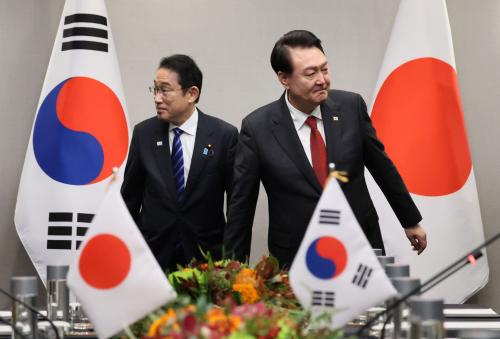
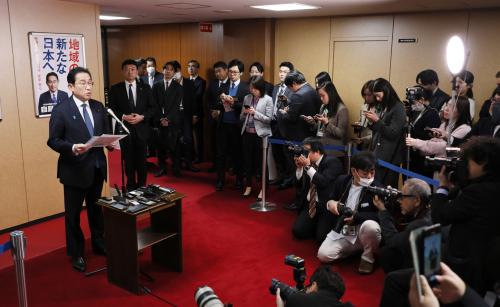
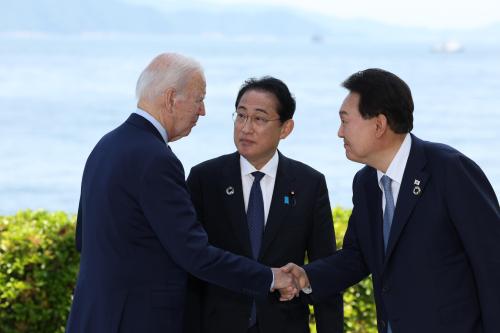

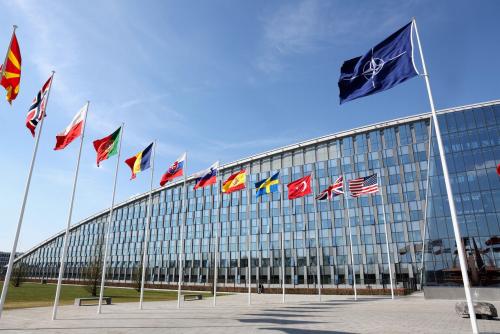
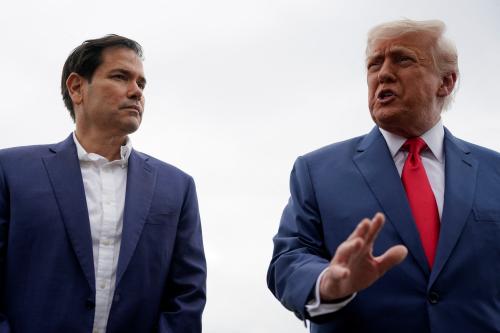
Commentary
The Biden-Kishida summit: An elevated partnership faces potential disruption
April 5, 2024